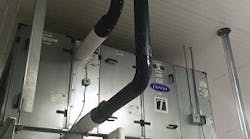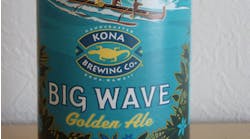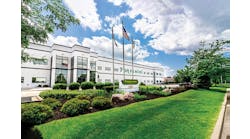Ammonia and propane gas instead of fluorocarbons for cooling are steps in the right direction. So is the use of secondary refrigeration systems, which reduce the amount of environmentally unfriendly primary charge (Freon gas, ammonia, etc.) in a plant by about 80 percent by using a safer, secondary coolant as the predominant means for cooling throughout a plant.
Leaks in standard refrigeration systems in metal piping systems can be as high 35 percent of the original charge per year, says one company in the business. This is not only damaging to the environment and a safety hazard, it's also costly to refill the system. Secondary cooling systems offer higher safety, lower refill costs, higher temperature stability and control, lower maintenance costs and are more environmentally friendly.
One end-user, Tasteful Selections LLC, a specialty potato grower and potato processing company made such as choice when it moved into a new 200,000-sq.-ft. plant in Bakersfield, Calif., in 2014.
“The new building gave us the opportunity to start with a blank page and design a cooling system that was completely safe for our employees as well as our products," says Nathan Bender, co-owner and operations manager. "At our previous location, about 75 percent of our cooling system was ammonia. This posed a huge safety threat to our employees as well as our products. If you hit one of those pipes, you’re dead."
With so much of the former building having ammonia, the chance of a leak or a forklift hitting a pipe weighed heavily on managers. “We were constantly on the alert for pin-hole leaks caused by corroding metal pipes,” says Bender. “We really wanted to get away from this type of hazard at our new plant. We just didn’t want ammonia throughout our new facility.”
Tasteful Selections named Techmark Inc., a provider of computerized ventilation systems, as primary contractor on the HVAC system. Techmark proposed a system that would isolate the refrigerant from the workspace and the product. Ammonia refrigerant would be confined to the machine room and condensers, with liquid glycol pumped throughout the rest of the plant for refrigeration.
Techmark used a sub-contractor for the next step of the project, which was specifying and designing the piping system to be used. California Controlled Atmosphere (CalCA) had become familiar with a new piping system for food cooling, which the company thought would make a good choice for the job. The system was the Cool-Fit pre-insulated ABS pipe and fittings manufactured by GF Piping Systems, Irvine, Calif.
“By using the Cool-Fit plastic piping system, we could eliminate the difficulty of welding and installing heavy metal pipe," says Jay Kliewer, president of CalCA. "And because frictional pressure losses in the plastic are lower than in steel, we were able to use smaller pipe sizes, which saved not only on pipe cost, it also saved space and installation time.”
The final design and installation included more than 3,000 ft. of Cool-Fit pipe and fittings. The system prevents condensation, reduces on-site installation time to a minimum and increases the efficiency of the refrigeration system as a whole.
Having the ammonia contained in a small, controlled area of the plant also brought other advantages. With the much lower level of ammonia refrigerant now used, Tasteful Selections is under the regulatory level requiring additional safeguards, such as 24-hour security monitoring and the need for several ammonia certified staff.
“With a food grade glycol in a plastic piping system with most of it overhead, if there were a leak, or if someone were to hit a line, it’s going to be water, air or glycol,” says Bender. “It’s still an accident, but not a life or death accident.
"We were also able to take advantage of the Cool-Fit plastic piping. Its lighter weight made for easier installation and there was no need to beef up the roof structure to carry the load," he continues. "So we saved on installation and construction costs. And with the plastic pipe, it’s out of sight and out of mind — we don’t have to worry about corroding pipes, repainting or having the pipe X-rayed.”



